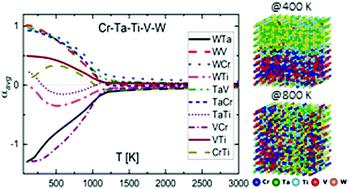当前位置:
X-MOL 学术
›
Phys. Chem. Chem. Phys.
›
论文详情
Our official English website, www.x-mol.net, welcomes your
feedback! (Note: you will need to create a separate account there.)
Chemical short-range order in derivative Cr–Ta–Ti–V–W high entropy alloys from the first-principles thermodynamic study
Physical Chemistry Chemical Physics ( IF 2.9 ) Pub Date : 2020-10-08 , DOI: 10.1039/d0cp03764h Damian Sobieraj 1, 2, 3, 4, 5 , Jan S. Wróbel 1, 2, 3, 4 , Tomasz Rygier 1, 2, 3, 4 , Krzysztof J. Kurzydłowski 4, 6, 7, 8 , Osman El Atwani 9, 10, 11 , Arun Devaraj 11, 12, 13, 14 , Enrique Martinez Saez 9, 10, 11 , Duc Nguyen-Manh 5, 15, 16, 17, 18
Physical Chemistry Chemical Physics ( IF 2.9 ) Pub Date : 2020-10-08 , DOI: 10.1039/d0cp03764h Damian Sobieraj 1, 2, 3, 4, 5 , Jan S. Wróbel 1, 2, 3, 4 , Tomasz Rygier 1, 2, 3, 4 , Krzysztof J. Kurzydłowski 4, 6, 7, 8 , Osman El Atwani 9, 10, 11 , Arun Devaraj 11, 12, 13, 14 , Enrique Martinez Saez 9, 10, 11 , Duc Nguyen-Manh 5, 15, 16, 17, 18
Affiliation

|
The development of high-entropy alloys (HEAs) focuses on exploring compositional regions in multi-component systems with all alloy elements in equal or near-equal atomic concentrations. Initially it was based on the main idea that high mixing configurational entropy contributions to the alloy free energy could promote the formation of a single solid solution phase. By using the ab-initio based Cluster Expansion (CE) Hamiltonian model constructed for the quinary bcc Cr–Ta–Ti–V–W system in combination with Monte Carlo (MC) simulations, we show that the phase stability and chemical short-range order (SRO) of the equiatomic quinary and five sub-quaternary systems, as well as their derivative alloys, can dramatically change the order–disorder transition temperatures (ODTT) as a function of alloy compositions. In particular, it has been found, that the equiatomic quaternary Ta–Ti–V–W and Cr–Ta–Ti–W alloys had the lowest order–disorder transition temperature (500 K) among all the analysed equiatomic compositions. In all investigated alloy systems, the strongest chemical ordering has been observed between Cr and V, which led to the conclusion that decreasing the concentration of either Cr or V might be beneficial in terms of decreasing the ODTT. It also predicts that increasing concentration of Ti significantly decreases the ODTT. Our analysis of chemical SRO as a function of alloy composition allows to understand the microstructure evolution of HEAs as a function of temperature in excellent agreement with available experimental observations. Importantly, our free energy of mixing and SRO calculations predict that the origin of precipitates formed by Cr- and V-rich in the sub-quaternary Cr–Ta–V–W system is driven by the thermodynamics. The modelling results are in an excellent agreement with experimental observation of Cr and V segregation in the W0.38Ta0.36Cr0.15V0.11 alloy which in turns shows an exceptional radiation resistance.
中文翻译:

第一性原理热力学研究衍生的Cr-Ta-Ti-V-W高熵合金的化学短程有序
高熵合金(HEA)的开发集中在探索多组分体系中的组成区域,其中所有合金元素的原子浓度相等或接近。最初,它基于主要思想,即对合金自由能的高混合构型熵贡献可促进单一固溶体相的形成。通过使用基于ab-initio的簇扩展(CE)哈密顿量模型,该模型是为五元bcc Cr–Ta–Ti–V–W系统构建的,并与蒙特卡洛(MC)模拟相结合,证明了相稳定性和化学短程等原子五元体系和五个亚四元体系的阶数(SRO)以及它们的衍生合金可以极大地改变作为合金成分的函数的有序-无序转变温度(ODTT)。特别是发现 Ta-Ti-V-W和Cr-Ta-Ti-W等原子四元合金在所有分析的等原子成分中具有最低的有序-无序转变温度(500 K)。在所有研究的合金系统中,在Cr和V之间观察到最强的化学有序性,从而得出结论,降低Cr或V的浓度可能会降低ODTT。它还预测增加的Ti浓度会显着降低ODTT。我们对作为合金成分的函数的化学SRO的分析可以理解HEA随温度变化的微结构演变,并且与现有的实验观察非常吻合。重要的,我们的混合自由能和SRO计算预测,在次季Cr–Ta–V–W系统中,富Cr和富V形成的沉淀物的起源是由热力学驱动的。模拟结果与W中Cr和V偏析的实验观察非常吻合0.38 Ta 0.36 Cr 0.15 V 0.11合金,因而具有出色的耐辐射性。
更新日期:2020-10-19
中文翻译:

第一性原理热力学研究衍生的Cr-Ta-Ti-V-W高熵合金的化学短程有序
高熵合金(HEA)的开发集中在探索多组分体系中的组成区域,其中所有合金元素的原子浓度相等或接近。最初,它基于主要思想,即对合金自由能的高混合构型熵贡献可促进单一固溶体相的形成。通过使用基于ab-initio的簇扩展(CE)哈密顿量模型,该模型是为五元bcc Cr–Ta–Ti–V–W系统构建的,并与蒙特卡洛(MC)模拟相结合,证明了相稳定性和化学短程等原子五元体系和五个亚四元体系的阶数(SRO)以及它们的衍生合金可以极大地改变作为合金成分的函数的有序-无序转变温度(ODTT)。特别是发现 Ta-Ti-V-W和Cr-Ta-Ti-W等原子四元合金在所有分析的等原子成分中具有最低的有序-无序转变温度(500 K)。在所有研究的合金系统中,在Cr和V之间观察到最强的化学有序性,从而得出结论,降低Cr或V的浓度可能会降低ODTT。它还预测增加的Ti浓度会显着降低ODTT。我们对作为合金成分的函数的化学SRO的分析可以理解HEA随温度变化的微结构演变,并且与现有的实验观察非常吻合。重要的,我们的混合自由能和SRO计算预测,在次季Cr–Ta–V–W系统中,富Cr和富V形成的沉淀物的起源是由热力学驱动的。模拟结果与W中Cr和V偏析的实验观察非常吻合0.38 Ta 0.36 Cr 0.15 V 0.11合金,因而具有出色的耐辐射性。











































 京公网安备 11010802027423号
京公网安备 11010802027423号